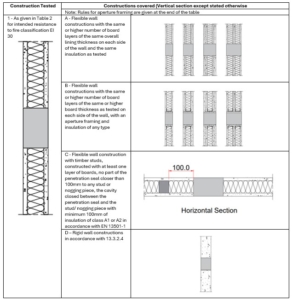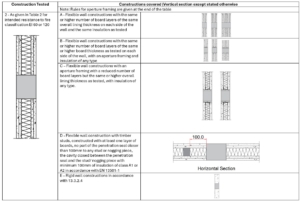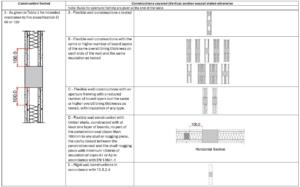The interchangeability of supporting constructions Firestopping FAQs
Building regulations require high-rise and multi-occupancy buildings to have effective compartmentation as a means of minimising the spread of fire within a building. Briefly, compartmentation is an element of passive fire protection which contains a fire to its area of origin for as long as possible. It is achieved by dividing the premises into areas of manageable risk.
On site, you will see a wide variety of fire-separating wall constructions used. As a manufacturer of tested firestopping solutions, we know that it is not practical to fire test every possible wall construction with identical firestopping applications. Therefore, the BS EN 1366-3:2021 fire-resistance test standard has produced general rules to allow fire test evidence to be used across certain supporting construction wall types.
The interchangeability of supporting construction rules can be located in section 13.3.2 of the BS EN 1366-3:2021 fire-resistance test standard. See below:
13.3.2 Double-sided flexible wall constructions
13.3.2.1
Test results obtained with the standard double-sided flexible wall construction in accordance with 7.2.2.1.2.1 may be used for all double-sided flexible wall constructions (with and without insulation) of the same or higher fire resistance classification as per EN 15301-2. This is with lining made of Gypsum boards as per EN 520, or Calcium Silicate boards based on an ETA for the application as lining of flexible walls, if their construction is in accordance with the rules given in Table 5.
Table 5 – Field of direct application rules for double-sided flexible wall constructions



The framing for an aperture, as specified in Table 5, must consist of studs and/or boards matching the specifications of the wall construction. Boards utilised for this framing should have a minimum thickness of 12.5mm. Circular apertures require a dimensionally stable sleeve from materials classified as A1 or A2 according to EN 13501-1 standards.
When installing the penetration seal, if one or more studs are cut, measures shall be taken to ensure the aperture lining within the flexible wall is supported by the studs (transoms and mullions). This is so that the mechanical load imposed by the penetration seal does not affect the stability of the aperture lining and flexible wall.
Regarding the increase of the overall wall thickness, the same rules for rigid walls apply. For rules around pipe closure devices, positioned within a wall/floor, see E.4.6.2.
13.3.2.2
An aperture framing or void closing used in the test is considered as being part of the penetration seal and shall be used in practice. Tests without an aperture framing cover applications with aperture framing (made of materials in accordance with 13.3.2.1) but not vice versa.
13.3.2.3
The standard double-sided flexible wall construction does not cover sandwich panel constructions and one-sided flexible wall constructions. Penetration seals in sandwich panel constructions shall be tested on a case-by-case basis.
13.3.2.4
Test results obtained with double-sided standard flexible wall constructions may be applied to rigid constructions of an overall thickness equal to or greater than that of the element used in the tests, and a minimum density of 350kg/m³. For rules regarding increased thickness, see Annex E. In the case of hollow brick walls, the same rules relating to aperture framing apply to double-sided flexible walls.
13.3.2.5
Test results obtained with double-sided flexible wall constructions of a smaller size than required, in accordance with 7.2.2.1.2.1 (non-standard double-sided flexible wall constructions), may be applied to concrete or masonry elements of an overall thickness. This is equal to or greater than that of the element used in the tests and at a minimum density of 350kg/m³ but not for flexible wall constructions. Regarding greater thickness than tested and hollow brick walls, see guidance 13.3.2.4.
Quelfire note
Section 7.2.2.2.1 concerns the requirements for flexible walls that will be positioned onto a fire furnace to carry out a fire test. Additional caveats/provisions allow the general rules stated above from BS EN 1366-3:2021 to be used.
The supporting construction type you will use on site should have been fire tested to a relevant test standard, such as BS EN 1363-1 or BS EN 1364-1, and classified for a fire-resistance rating by BS EN 1501-2:2016.
For guidance on the wall system, its construction, and limitations, you should speak to the wall manufacturer directly, avoiding confusion about the details in section 7.2.2.2.1.
The overall fire performance classification of the compartmentation is limited by the lowest classification of the wall, service penetrations, and linear gap seals. That is why it is vital at the design stage to consider all factors, as certain service penetration types cannot be firestopped to achieve the required fire-resistance rating of the wall. For instance, an uninsulated copper pipe may not be able to achieve EI 120, which would align with your wall’s fire rating. This is due to copper being a good conductor of heat, affecting the insulation rating.
If you have any further questions about the interchangeability of wall constructions, please don’t hesitate to contact us at technical@quelfire.co.uk.

